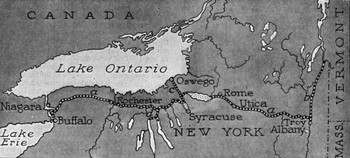Part 3: Clinton Has the Last Laugh It wasn't a quick process by any means. Construction dragged on. Critics called it "Clinton's Folly" or "Clinton's Big Ditch." Much of western New York at that time was swampland. Digging a canal and installing locks was time-consuming and expensive and had to be done basically by hand. But Clinton stayed the course. He believed in the promise of the Canal, and he got the necessary funding to get it built. And when it opened, he was on hand to usher it into existence. The first complete passage through the canal, from Lake Erie to New York City, took place on October 26, 1825. It was 363 miles in length. It had 18 aqueducts and 83 locks. It was four feet deep and could handle boats that weighed up to 30 tons.
The Erie Canal was an overnight success. Farmers could ship their wheat, salt, and other goods to New York City and out to other countries. New York farmers were ecstatic. It wasn't just wheat and salt, either. It was produce, fruits and vegetables, that could get to New York City. Before, when these goods had to go by wagon, they would spoil by the time they got to New York; now, they could sail down the Canal and not spoil on the way. All the money that New York spent on building the Erie Canal came back in just 10 years. The Canal made New York City the country's fifth biggest seaport. Syracuse, a small city along the Canal, blossomed into a big city with a respectable population and reputation. (Sadly, DeWitt Clinton died just three years after the opening of the Canal. He lived to see his dream become a reality, though.) One drawback, as far as New York farmers were concerned, was that the Erie Canal was soon part of a waterway network that included produce and wheat from other states. New York didn't have a monopoly on what came through the Canal. Still, the Canal itself created a big boom in business, going both ways. It also increased settlement in western New York and in other states bordering the Great Lakes, as immigrants who entered New York from Europe sailed up the Hudson River and west across New York to Buffalo, Chicago, and other points west.
The Erie Canal itself was expanded and widened several times in its history, before it was finally replaced—by roads and streets and railroad tracks. First page > Expansion in Their Minds > Page 1, 2, 3 |
|
Social Studies for Kids
copyright 2002–2025
David White


 As with the
As with the 
